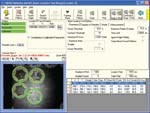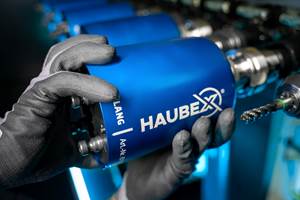Is Robotic Automation Becoming Practical For Low-Volume Production?
High-volume manufacturing and robotic automation go hand in hand. Machine-tending robots used in these production schemes need not be very flexible, as they may just load and unload one type of part hundreds of thousands of times.
High-volume manufacturing and robotic automation go hand in hand. Machine-tending robots used in these production schemes need not be very flexible, as they may just load and unload one type of part hundreds of thousands of times.
However, this lack of flexibility to adapt to frequent job change-overs and small batch sizes is what has hindered robotic automation's integration into contract shops. The V-500iA PC-based vision system, developed by FANUC Robotics America, Inc. (Rochester Hills, Michigan), was designed to make robotic automation of low-volume manufacturing practical so shops of all sizes can enjoy the benefits that automated machine tending offers—higher spindle utilization, the possibility for automatic deburring, gaging or assembly, and smarter use of labor.
According to Richard Johnson, FANUC's general manager of material handling, this latest PC-based vision technology enables robots to pick parts without the use of dedicated part-positioning fixtures. Parts now can be presented to a robot in a less structured manner (on a belt conveyor, for example), and robot setup may be just a matter of changing the robot's gripper to pick a new type of part. In addition to locating parts, the vision technology can also discern between different parts within a part family.
Here Mr. Johnson addresses some questions that contract shops may have about current vision systems for machine-tending robots.
- Where does the camera mount? A vision system starts with one or more cameras, which essentially snap photos of a part so the system's software can determine part location and orientation. A camera can be installed onto a robot's articulating arm to allow image capture from a variety of angles. Static cameras may be mounted remotely above or adjacent to the location where a robot would pick a part. Remote mounting allows cameras to be positioned higher than a robot's arm can reach to maximize the camera's depth of field. For parts stored on a multi-level tray magazine, for example, this high position allows the camera to focus on every tray from top to bottom.
- Can current vision systems "see" better? Earlier vision systems were extremely sensitive to lighting and contrast. Those systems were binary-based—that is, each pixel in the image was either on or off. Many current vision systems are grayscale-based and their software has post-processing capabilities that can further improve image quality. These grayscale systems are more forgiving than binary systems in terms of lighting and contrast, but effective lighting is always a key part of a vision system's reliability.
- How can parts be presented to a robot? Vision systems can locate parts that may be presented in numerous orientations on trays, conveyors or structured bins. FANUC offers fixtureless parts storage magazines, which use multiple trays that the robot can flip up and out of the way once emptied, allowing access to lower trays stocked with parts. The software used by the V-500iA system has a geometric pattern-matching feature that examines the geometry of an object, rather than looking for a trained pixel pattern. This is helpful in locating parts that may not be presented to the robot in the same orientation, or for parts that are partially covered.
- Does the application require a 2D or 3D system? For small parts located somewhere on an X-Y plane (such as on a conveyor or tray), a 2D system may suffice. For larger parts, or for parts presented to the robot that are offset in X, Y and Z planes (or yaw, pitch and roll), 3D is often required.
- What are the trends in robot design? Machine tending robots are becoming more compact, faster and stronger. Compact design allows easier relocation within a shop; faster robot speed can improve throughput; and increased payload capacity permits manipulation of larger parts.
Related Content
Fearless Five-Axis Programming Fosters Shop Growth
Reinvestment in automation has spurred KCS Advanced Machining Service’s growth from prototyping to low-and mid-volume parts. The key to its success? A young staff of talented programmers.
Read MoreLean Approach to Automated Machine Tending Delivers Quicker Paths to Success
Almost any shop can automate at least some of its production, even in low-volume, high-mix applications. The key to getting started is finding the simplest solutions that fit your requirements. It helps to work with an automation partner that understands your needs.
Read MoreUsing the Toolchanger to Automate Production
Taking advantage of a feature that’s already on the machine tool, Lang’s Haubex system uses the toolchanger to move and store parts, making it an easy-to-use and cost-effective automation solution.
Read More4 Steps to a Cobot Culture: How Thyssenkrupp Bilstein Has Answered Staffing Shortages With Economical Automation
Safe, economical automation using collaborative robots can transform a manufacturing facility and overcome staffing shortfalls, but it takes additional investment and a systemized approach to automation in order to realize this change.
Read MoreRead Next
The Cut Scene: The Finer Details of Large-Format Machining
Small details and features can have an outsized impact on large parts, such as Barbco’s collapsible utility drill head.
Read More3 Mistakes That Cause CNC Programs to Fail
Despite enhancements to manufacturing technology, there are still issues today that can cause programs to fail. These failures can cause lost time, scrapped parts, damaged machines and even injured operators.
Read More
.jpg;width=70;height=70;mode=crop)




.png;maxWidth=300;quality=90)





.png;maxWidth=300;quality=90)











